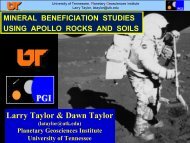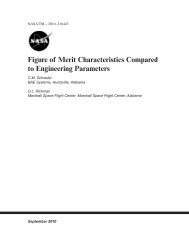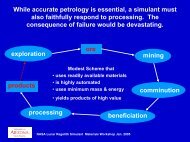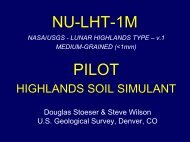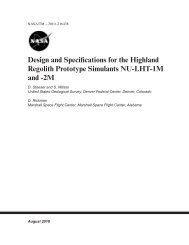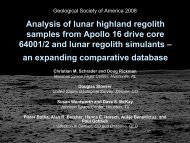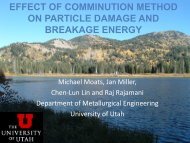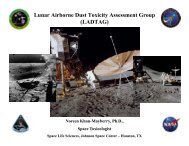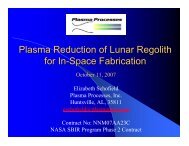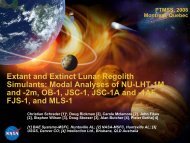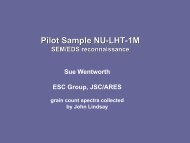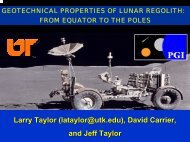Book of Abstracts- Lunar Regolith Simulant Materials Workshop
Book of Abstracts- Lunar Regolith Simulant Materials Workshop
Book of Abstracts- Lunar Regolith Simulant Materials Workshop
You also want an ePaper? Increase the reach of your titles
YUMPU automatically turns print PDFs into web optimized ePapers that Google loves.
THE EFFECTS OF LUNAR DUST ON ADVANCED EVA SYSTEMS: LESSONS FROM APOLLO. J.R.<br />
Gaier 1 , R.A. Creel 2 ; 1 NASA John H. Glenn Research Center, 21000 Brookpark Road, Cleveland, OH 44135,<br />
(james.r.gaier@nasa.gov), 2 SAIC, 21151 Western Avenue, Torrance, CA 90501 (ronald.a.creel@saic.com) .<br />
Introduction: NASA’s Vision for Space Exploration<br />
has as its fundamental goal the advancement <strong>of</strong><br />
“…U.S. scientific, security, and economic interests<br />
through a robust space exploration program.”[1] The<br />
Vision is based around a spiral development that extends<br />
“…human presence across the solar system,<br />
starting with a human return to the Moon by the year<br />
2020…” The Advanced Extravehicular Activity<br />
(AEVA) program has been charged with developing<br />
both the technology and the flight hardware required<br />
for spacesuits, tools, and vehicular interfaces that will<br />
enable astronauts to work on the lunar surface.<br />
Apollo Lessons: One <strong>of</strong> the lessons learned from<br />
the Apollo program is that lunar dust has the potential<br />
to degrade EVA systems through a variety <strong>of</strong> mechanisms.<br />
Mission documents from the six Apollo missions<br />
that landed on the lunar surface reveal dust degradation<br />
effects that can be sorted into nine categories:<br />
vision obscuration, false instru-ment readings, dust<br />
coating and contamination, loss <strong>of</strong> trac-tion, clogging<br />
<strong>of</strong> mechanisms, abrasion, thermal control problems,<br />
seal failures, and inhalation and irritation. The properties<br />
<strong>of</strong> lunar dust with respect to these adverse effects<br />
must be understood and replicated if the AEVA systems<br />
are to be designed to operate effectively on the<br />
lunar surface.<br />
The first dust-related problem experienced by the<br />
Apollo astronauts occurred when they attempted to<br />
land the <strong>Lunar</strong> Module (LM). The Apollo 11 crew<br />
reported that “Surface obscuration caused by blowing<br />
dust was apparent at 100 feet and became increasingly<br />
severe as the altitude decreased.”[2] This was even<br />
more <strong>of</strong> a problem for Apollo 12 where there was total<br />
obscuration in the last seconds before touchdown to<br />
the extent that there was concern that one <strong>of</strong> the landing<br />
feet could land on a boulder or in a small crater[3].<br />
For Apollo 14 the landing pr<strong>of</strong>ile was adjusted to be<br />
steeper, and the astronauts reported little difficulty in<br />
seeing the landing site[4]. However, this may have<br />
been due in part to the Apollo 14 landing site being<br />
intrinsically less dusty, because Apollo 15 and Apollo<br />
16 also used the higher landing pro-file, and both reported<br />
difficulties seeing the landing site in the critical<br />
last seconds [5, 6].<br />
In Apollo 12 the velocity trackers gave false readings<br />
when they locked onto moving dust and debris<br />
during de-scent [3]. The Apollo 15 crew also noted<br />
that landing radar outputs were affected at an altitude<br />
<strong>of</strong> about 30 feet by mov-ing dust and debris [5]. But<br />
the Apollo 17 crew reported no lock-up on moving<br />
dust or debris near the lunar surface [7]. This again<br />
points out the differences in the amount <strong>of</strong> dust at the<br />
different landing sites, with it being high at the Apollo<br />
12 and 15 sites, and low at the Apollo 17 site.<br />
The Apollo experience then reveals that the extent<br />
that vision and radar obscuration is a problem on landing<br />
is de-pendent on the amount <strong>of</strong> loose dust in the<br />
specific landing zone. Thus, it will probably remain a<br />
variable as long as spacecraft are landing in previously<br />
unexplored territory.<br />
In addition to vision obscuration on landing, the<br />
dust caused minor problems with photography. The<br />
Apollo 15 crew reported problems with a halo effect<br />
on the television camera transmission. This was remedied<br />
by brushing the dust <strong>of</strong>f <strong>of</strong> the lens [5].<br />
Neil Armstrong reported dust material adhering to<br />
his boot soles caused some tendency to slip on the<br />
ladder during ingress back to the LM [2]. However,<br />
this slipperiness was not reported by any <strong>of</strong> the other<br />
crew members, and there are specific references in the<br />
Apollo 12 record that this was not a problem for them<br />
[3]. It became standard practice for the astronauts to<br />
kick the excess dust <strong>of</strong>f <strong>of</strong> their boots on the ladder<br />
before they re-entered the LM in an attempt to keep as<br />
much dust as possible out <strong>of</strong> the spacecraft, and it is<br />
likely that this measure was enough to keep this from<br />
happening.<br />
Dust was found to quickly and effectively coat all<br />
sur-faces it came into contact with, including boots,<br />
gloves, suit legs, and hand tools. Consequences included<br />
the Apollo 11 astronauts repeatedly tripping<br />
over the dust covered TV cable [2], and a contrast<br />
chart on Apollo 12 becoming unusable after being<br />
dropped in the dust [3]. This was particularly troublesome<br />
on Apollo 16 and 17 when rear fender extensions<br />
were knocked <strong>of</strong>f <strong>of</strong> the <strong>Lunar</strong> Roving Vehicle<br />
(LRV) and dust showered down on top <strong>of</strong> the astronauts<br />
[6,7]. Dust coating is the precursor to other<br />
problems such as clogging <strong>of</strong> mechanisms, seal failures,<br />
abrasion, and the compromising <strong>of</strong> thermal control<br />
surfaces. In addition, valuable astro-naut time<br />
was spent in ordinary housekeeping chores like brushing<br />
<strong>of</strong>f and wiping down equipment – which <strong>of</strong>ten<br />
proved ineffective.<br />
Equipment was compromised by dust clogging and<br />
jamming in every Apollo mission. This included the<br />
equipment conveyor [2], lock buttons [3], camera<br />
equipment [5], and even the vacuum cleaner designed<br />
to clean <strong>of</strong>f the dust[6]. Dust made Velcro ® fasteners<br />
21



